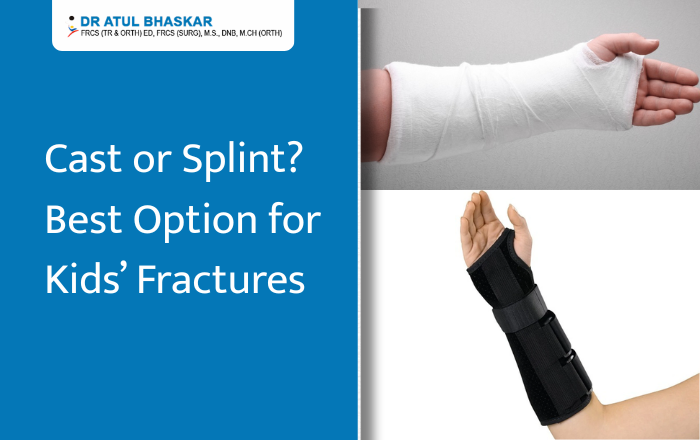
When your child gets hurt, especially if it might be a broken bone, it’s stressful. One of the first questions that comes up is whether they need a cast or a splint. It’s not always easy to tell which is better—and most parents just want to do the right thing as quickly as possible.
This article will walk you through the difference between a cast and a splint, how doctors decide between them, what healing looks like, and what parents need to know to make smart choices.
Let’s break it down in simple terms.
Kids are active. They climb, run, fall, and bounce right back up—most of the time. But growing bones are softer than adult bones, so they break more easily. A small trip or a fall from a swing can lead to a fracture.
Common fracture spots in children include:
Signs Your Child Might Have a Fracture
If any of these signs are there, it’s best to see a pediatric orthopedic doctor right away.
Both casts and splints are used to keep a broken bone in place so it can heal. But they’re not the same thing.
A cast is a hard shell made from fiberglass or plaster. It wraps around the limb completely and holds the bone steady.
When casts are used:
Pros:
Cons:
A splint is sometimes called a half-cast. It supports only one side of the limb and is held on with bandages or Velcro.
When splints are used:
Pros:
Cons:
The choice between a cast and a splint isn’t random. Doctors look at a few key things:
Example:
A small crack in the wrist might heal well with a splint. But a full break near the elbow probably needs a cast to keep the joint stable.
How Long Does It Take to Heal?
It depends on the break. But in most cases:
Kids heal faster than adults, but they also need more careful checks because their bones are still growing.
Tips:
There’s no clear “better” option it all comes down to what the injury needs.
| Condition | Cast | Splint |
|---|---|---|
| Full bone break | ✅ Yes | ❌ No |
| Minor crack | ❌ Not always needed | ✅ Often enough |
| Swelling present | ❌ Not ideal at first | ✅ Gives room to adjust |
| Long-term healing needed | ✅ Strong and secure | ❌ Usually temporary |
If you’re unsure, don’t guess—ask a pediatric orthopedic doctor who works with kids regularly.
Q: Is a splint strong enough for a broken bone?
It can be, if the break is small or hasn’t shifted. Doctors often use splints first, then switch to a cast once swelling goes down.
Q: Can my child take off the splint at home?
Only if the doctor says so. Some splints are made to be removable. Others aren’t.
Q: Will my child need physical therapy after the cast or splint?
Not always. Most kids bounce back fast. But if movement is stiff after healing, therapy might help.
Choosing between a cast or a splint isn’t just about comfort—it’s about healing the right way. The best choice depends on the type of fracture, the child’s age, and how their bones are growing. Always follow the advice of a pediatric orthopedic specialist who understands how children heal.
If your child has a broken bone or you’re unsure what kind of treatment they need, don’t wait and wonder.
Reach out to Dr. Atul R. Bhaskar, a trusted Pediatric Orthopedic Doctor in Mumbai with 33+ years of experience helping children recover from fractures and other bone injuries. He has treated thousands of kids with care, skill, and the kind of calm that reassures both parents and little ones.
Dr. Atul Bhaskar, one of the prominent Paediatric Orthopaedic Surgeon in India has graduated from Seth G S Medical College, Mumbai. After doing his M.S (Orth) from K.E.M. Hospital, he pursued further training in the United Kingdom. He was on the “Yorkshire Orthopaedic Training Program” and obtained his orthopaedic fellowship, FRCS (Orth) and Surgical fellowship, FRCS (Glasgow) degrees. He has received the M.Ch Orth form Liverpool.
© Copyright 2025 Dr. Atul Bhaskar | All rights reserved.
Designed By DMX Digital